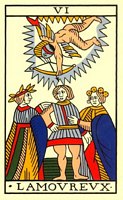conversus
Nicky:
He looks a little like the Mouthpiece of Sauron to me. I'd try to stay out of his orbit. . .
CED
He looks a little like the Mouthpiece of Sauron to me. I'd try to stay out of his orbit. . .
CED
He DOES!!!!!!conversus said:Nicky:
He looks a little like the Mouthpiece of Sauron to me. I'd try to stay out of his orbit. . .
CED
 That will keep me giggling all evening!
That will keep me giggling all evening! 
conversus said:
The blind Cupid can remind us that sometimes it is not so much ourselves that choose Love ; but it is Love that chooses us—taking us beyond ourselves for weal or woe.
prudence said:I think I have read that the Papesse is a metaphorical symbol for "The Church" itself...
kwaw said:The papesse looks not into the open book in her lap, but upon the juggler: as the Catholic church looks upon transubstantion, purgatory, veneration of saints and relics, miracles and other such juggleries rather than upon scripture.
kwaw said:The papesse looks not into the open book in her lap, but upon the juggler: as the Catholic church looks upon transubstantion, purgatory, veneration of saints and relics, miracles and other such juggleries rather than upon scripture.
conversus said:In the 15th Century, just as today, the Eastern and Western Church would have looked upon transubstantiation, purgatory, the veneration of saints and the relics of the saints, the expectation of miracles not as some distraction from the Scriptures, but as rooted deeply in the Scripture that the Popesse holds in her lap, as on a throne.
CED
